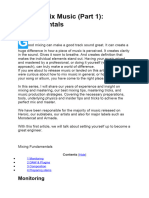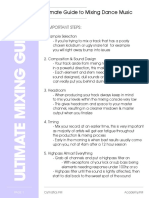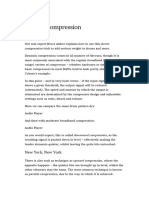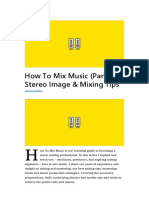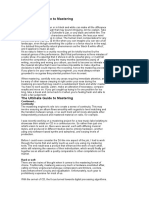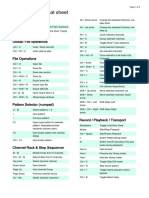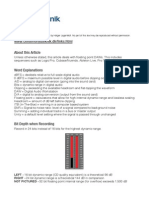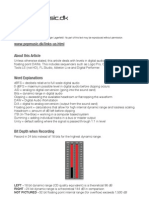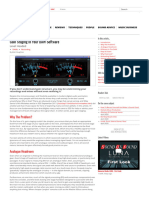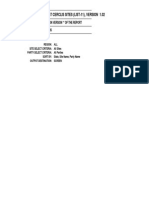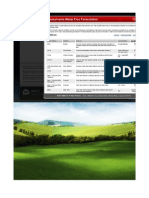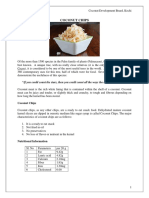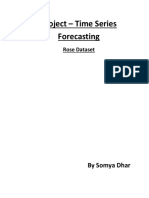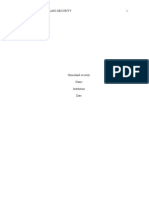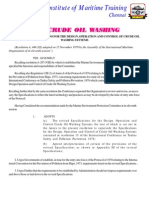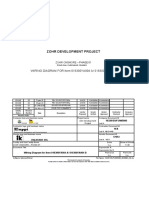Im not surprised: to anyone who learned
to mix with analogue consoles and
outboard gear, this is all second nature,
because the gear effectively forced good
practice on you.
Analogue Headroom
Even when an engineer is hitting
the maximum level on the meters of
professional analogue gear, theres bags
of headroom left to accommodate stray
high-level peaks, or particularly loud
passages: if your signal is measuring 0VU
on an analogue meter, then, assuming
its a professional-standard device, where
0VU = +4dBu, therell be at least 20dB of
headroom, and often considerably more;
the signal can peak well above 0VU and
cause no problems. Even with particularly
high peak-to-average ratio sources such
as a loud snare drum, the peak may be
gracefully clipped by the analogue
circuitry in the digital domain, by
contrast, clipping produces anharmonic
distortion which sounds very ugly.
Furthermore, at one time, much of
the signal processing (EQ and sometimes
compression) was built into consoles, and
the levels leaving one stage had been
designed to just work with the next,
from a user point of view; youd have to
try very hard to get unacceptably high
levels on the main mix bus. Even where
outboard processors were employed,
they would be plumbed in and the meters
calibrated, so that when you were mixing
you didnt need to think about anything
but mixing. When cheaper project
consoles such as the Mackie 8 Buss came
along, there might have been a little less
headroom than in the Neves, APIs and
SSLs of this world, but the situation was
essentially the same.
Different In The DAW
In the modern software-based production
environment, though, many people dont
completely appreciate what appropriate
levels are, or even correctly understand
the notions of headroom and dynamic
range. This is understandable: after all, at
least one generation has now grown up
trying to teach themselves mixing using no
more than a computer, a piece of software
and the vast resource of conflicting,
variable-quality advice on the Web.
Bad advice aside, I believe there are
also several reasons why the DAW software
itself leads people to make mistakes.
Partly, I think its due to the huge amounts
of internal headroom offered by modern
32- and 64-bit floating-point software
you could theoretically describe a dynamic
range of a whopping 1500dB in a 32-bit
floating-point system without causing
problems. That enables you to apply
serious amounts of gain if you wish in
theory! In practice, many people, including
me, believe that the summing engines
in different DAWs dont always produce
the same results when summing lots of
very high-level signals, and that these
differences can be audible. The probable
reason for this, to put it simply, is down
to differences in how the 32- or 64-bit
floating-point calculations are rounded
to create the 24-bit audio part of the
floating-point data.
More commonly, problems arise
when you introduce plug-in effects and
M A T T H O U G H T O N
D
espite the immense power
and flexibility available in
modern digital audio worstation
software, may people still find that the
mixes they craft entirely in the box
sound unsatisfying. Why is that? There
are obviously many things that can go
wrong, and Mike Seniors Mix Mistakes
article in SOS September 2011 (www.
soundonsound.com/sos/sep11/articles/
mix-mistakes.htm) did a better job than
I have space for here of exploring many
common pitfalls. In this article, Ill focus
on one fundamental issue that blights
many tracks sent to SOS for help or
advice: poor management of levels
throughout the signal chain. In other
words, poor gain staging.
Why The Problem?
On the face of it, gain staging couldnt
be simpler: you ensure that you feed an
appropriate level from the first stage
of your signal path to the next, and
repeat this from the second stage to the
third... and so on, all the way from your
instruments, mics and preamps to the final
stereo mix bus. By appropriate, I mean
an ample level, which ensures a healthy
signal-to-noise ratio (the difference
between the wanted signal and the noise
floor), while leaving enough headroom
that you neednt worry about whether the
signal might be clipping.
Ive seen plenty of online discussions
in which seasoned engineers are shocked
by the ignorance of many would-be
engineers about managing signal levels.
Gain Staging In Your DAW Software
If you dont understand gain structure, you may
be undermining your recordings and mixes
without even realising it.
LEVEL HEADED
T E CHNI QUE
136 September 2013 / www. s oundons ound. c om
processors, because
some are just not
designed to operate
well when presented
with very hot signal
levels. Im not
referring exclusively
to cheap plug-ins,
either: there are some
fantastic-sounding
plug-ins by the likes of Waves,
Slate and Sonnox that audibly suffer if
you overload them.
Analogue-modelling plug-ins, in
particular, seem susceptible to this
sort of abuse: they often do a great
job of mimicking the sonic behaviour
of their hardware equivalent in its
normal operating range, but start
to fall down when you push them
outside that range. My assumption
(which Ive yet to verify) is that this is
because modelling the increasingly
complex non-linearities of analogue
gear as you feed hotter and hotter
levels into it takes up so much DSP
power. If the tool is used as intended,
theres just no need to model that
behaviour accurately, and users will
often prefer a more resource-efficient
plug-in in any case.
Happily, most plug-ins offer input
and output level controls, and often
meters too, so you can boost or
attenuate at any stage. What this
all boils down to is that, despite the
apparently forgiving nature of 32-bit
and 64-bit floating-point processing,
you still need to be aware of and
manage the levels at every stage
of your mix, and to be aware of the
impact these levels have on your
softwares sonic performance.
Keep It Down!
The good news is that all of these
problems can be avoided if you work
with audio at sensible levels in the first
place! In other words, if you adopt the
analogue approach and leave plenty
of headroom right the way through
your digital signal path, everything
should be just fine. Meanwhile, if
you find that you need things louder
when youre mixing, use the volume
knob on your monitor controller, amp
or speakers, because its perfectly
possible to increase the loudness of
a mix during a mastering process,
but its not possible to rescue an
overloaded mix by turning it down.
Working in this way, when you find
that you need to raise a channel fader,
apply an EQ boost or do whatever
other process that adds level, you
have room to do so without needing
to think about it. In fact, thats a good
way of looking at this whole subject:
gain-staging is about providing you
with a safety buffer.
Why Overcook?
Theres nothing inherent in 32-bit and
64-bit DAW systems that encourages
people to use ridiculously high-level
signals. So why do they? Obviously
no-ones told them, or the message
hasnt got through, but quite apart
from that I can see some factors that
might convince someone that its
a good idea. One is about adhering
to outdated practice, while the others
relate to the DAW software itself.
First, theres the archaic practice of
recording levels as hot as possible, in
order to maximise the signal-to-noise
ratio of the digitally captured audio.
This was important in the days of
16-bit digital recording, where the
dynamic range of the recording
medium was relatively restricted, and
when converters didnt apply dither
When youre using
a professional audio
interface, -12dBFS is
broadly equivalent to
the nominal signal peak
levels on an analogue
console, so theres no
need to let your DAWs
channel levels peak
anywhere near 0dBFS.
screen real-estate! It occurs to me that the
sample-peak meter is a throwback to the
early days of digital recording, when, as
Ive mentioned, it was necessary to record
as hot as possible without clipping and
that no-one has thought to abandon or
replace them since that time.
The point is that this sample-peak
metering is very different from the
metering youd find on a typical analogue
console. Analogue meters, whether they
take the form of a moving-coil device or
a stack of LEDs, are always integrating
types of one sort or another: theyre
designed to display the average level of
a signal calculated over a defined window
of time, and the analogue electrical and
mechanical components mean that they
effectively have a built-in attack time.
Theyre deliberately designed not to
react to the briefest transients that would
register on a sample-peak meter in the
analogue domain, these are not a problem,
because of all the headroom. The VU
meters of analogue consoles calculate that
average over a relatively long time window
(about 300ms), and even though the PPMs
beloved of broadcast professionals use
a much shorter window (about 10ms),
they still dont display true peaks, which
is why theyve often been referred to
colloquially as fake peak or quasi-peak
meters. The benefit of both these types
of meter at least in relation to digital
sample-peak meters is that they provide
a more effective indication of how close
or far away the signal is to/from a suitable
nominal level. (Note that this is different
from loudness metering of your stereo bus
output, discussed in the TC Electronic LM2
review elsewhere in this issue.)
Metering within DAWs can also mislead
if youre unsure exactly what is being
Related to this
issue is the use of
mastered mixes
as mix references. Using references is
a great way to train your ears, become
accustomed to your speakers and help
get your mixes into the right sonic
ballpark. However, the mastering process
strips off the headroom margin that was
present during tracking and mixing.
Anyone unaware of this might assume
that the aim is to produce a raw mix that
hits 0dBFS and has an average level up
around -6dBFS, or whatever! This is most
definitely not the case. Lower the level
of your reference CD tracks to regain
that headroom and make them more
comparable with your mix level.
Misleading Meters?
The second way in which DAW software
can mislead is in its digital sample-peak
metering. Thats used by default in all
DAW mixers (although, thankfully, progress
is at last being made in meaningful
loudness metering on the stereo mix bus).
The sample-peak meter indicates the
amplitude of the highest audio sample
at any moment in time, and provides an
approximation of the actual peak level of
the reconstructed audio waveform. The
approximation is perfectly adequate for
use on the stereo bus, or any channel
where you plan to send the signal out into
the analogue domain if youre working
with a sensible headroom margin since
any amplitude errors are non-critical.
Im not entirely sure why DAWs feature
large sample-peak meters on the main
mixer channels at all these days, though,
unless you use them while tracking. Theyre
only really of any use when mixing if you
fail to leave sufficient headroom in the first
place, and they provide you with very little
useful information that a couple of LEDs
couldnt, yet they take up vast swathes of
correctly or even at all! Its certainly not
the case now: DAW projects pretty much
all default to 24-bit recording and Im not
aware of a modern DAW that doesnt at
least offer that option. Digital recordings
at 24-bit resolution offer a greater dynamic
range than most users need ie. the
digital systems noise floor is so far below
the wanted signal that you just dont need
to think about it any more. Its easy to
achieve an ample signal-to-noise ratio while
leaving bags and bags of headroom. This
advice is more commonly given now, but its
not that long since I heard more than one
music production tutor offer poor advice on
this point, so its well worth repeating!
In case youre unconvinced, lets
compare dynamic range in the digital and
analogue realms. A top-notch analogue
mixer has a noise floor around -95dBu, or
maybe a little better, and clips at around
+24dBu, giving it a total dynamic range
of around 119dB. A typical mid-budget
computer interface will deliver exactly the
same dynamic range, and even budget
ones will manage 115dB or more. The very
best might make 125dB, which is a little
better than most really good analogue
systems. So, since analogue and digital
systems have exactly the same dynamic
range, theres no problem in using them
in exactly the same way, with the same
headroom margins, to deliver the same
kind of sound quality.
In the case of the DAW software,
I can see two major issues. The first is
shouty presets. Load a virtual synth in
your DAW and run a programmed MIDI
loop through it with notes set to a velocity
of 100. The chances are that the meters
are already into or approaching the red.
The sound wont clip its own DAW channel
so it wont cause problems if youre just
using the synth to do a live performance,
for example but if you run this patch
through some plug-ins, or route multiple
such patches through your mix bus and
any mix-bus processing, you can easily run
into problems.
Many people like to start a track with
a software drum machine and overdub
other parts as they build a composition
and mix, all as part of the same process. If
thats you, lesson number one is to use the
output-level control on your software synth
to turn it down to a sensible level and
claim back that headroom! Dont use your
mixer faders for this, because they wont
affect the level flowing from your synth to
any insert processors you add. Again, if this
sounds too quiet, turn up your monitors.
Your DAWs channel
meters are of little
practical use when
mixing with sufficient
headroom. Some
plug-ins, including the
pictured one by Zplane,
enable you to mimic the
more useful analogue VU
and PPM meters but
theres no practical way to
display these readings for
all your mixer channels
simultaneously!
T E CHNI QUE
GA I N S TAGI NG I N Y OUR DAW S OF T WA R E
138 September 2013 / www. s oundons ound. c om
metered! Your DAW
meters default to
showing the level
at a certain point in
the signal chain, and
different DAWs have
different defaults: the
channels input signal
(ie. before any insert
processing) may be
being monitored,
or the signal could be post-panner (and
post-inserts) or post-fader. Its entirely
possible for your meters to look OK but
for you to be feeding massive levels to the
mix bus if, for example, youve used
compression with make-up gain or have
applied EQ boosts.
Most DAWs allow you to change where
the meter signal is tapped from, and some
allow more options than others. What
none do, as far as Im aware, is to indicate
the level between the insert slots. If thats
what you want, youll need to use the
meters on your plug-in processors and
effects, or dedicated metering plug-ins.
Thats a shame, as you dont have any
indication at a glance from your DAWs
mixer screen without having the plug-in
GUIs open. Ive often thought it might be
useful to have an (optional) input clip light
on each DAW insert slot and at the top
of each channel, not as a lazy means of
protection, but as an aid to tracking down
problems more quickly.
In short, then, when it comes to
metering, the digital sample-peak meters
of your DAWs mixer window tell you very
little. If you leave headroom, just as you
would in the analogue domain, you dont
really need them at all.
Setting Initial Levels
The advice in this article all boils down to
the need to allow headroom on all your
DAW channels, but, due to the difference
in metering types used in the analogue
and digital domains, this can seem more
complex in practice than it sounds. You
could, if you wished, insert virtual VU
or PPM meters on every channel of
your mix, but Im unaware of a DAW
that allows you to change the channel
metering in the mixer to an averaging
type, so theres no way that you can see
at a glance what all those insert meters
are doing. We have to work with the
tools at our disposal, although if youre
working entirely in the box you dont
need to mimic the analogue signal flow
so precisely. You dont even need to think
about the headroom of your interfaces
A-D or D-A converters, except in as much
as it interfaces with your monitoring chain
(another subject about which youll find
half-baked advice all over the Internet!).
However, you can make use of those
almost-useless peak meters.
If you take the sound with the highest
peak levels and set it so that it peaks at
between -12 and -18dBFS, you shouldnt
run into problems with plug-ins or
summing on the mix bus. If these figures
look different to those I discussed in
relation to analogue gear, remember
that the meters are different, and youre
actually leaving about the same 20dB
headroom. I wouldnt expect to see peaks
on the channel meters reading more than
-8 to -10dBFS (and lower is often better).
The highest level track in your mix will
vary, but in rock and pop its usually the
kick or snare. Set a rough balance of your
other tracks in relation to that track and
you should be good to go.
There are various means of setting that
initial level and which is best will depend
Some DAWs allow you to
customise your channel
meters. Here, Cubases
channel meters have been
configured to show red
at -10dBFS, yellow down
from -10 to -18dBFS,
and green below that.
Aiming for yellow will
give a good healthy signal
while leaving sufficient
headroom.
T E CHNI QUE
GA I N S TAGI NG I N Y OUR DAW S OF T WA R E
140 September 2013 / www. s oundons ound. c om
on the DAW youre using. Some allow
you to select and boost/attenuate all the
clips in the projects arrange window. I find
that a good tactic when working only with
audio files, as all the mixer controls remain
neutral, but it wont take account of any
virtual instrument channels. In some DAWs,
theres a dedicated gain control at the top
of the console channel strips, and you can
set each track to the desired level, or gang
the controls to preserve the balance while
tweaking. In others, youll find that you
need to insert dedicated gain plug-ins in the
first insert slot of each channel, and adjust
them to set an appropriate signal level. In
those cases, linking the controls may be
more difficult. In extreme cases, where
you have a project in which all the sources
are incredibly hot, you might think about
batch processing the files by lowering all
the faders and bouncing the results in place
(freeing up an insert slot in the process), but
I wouldnt suggest doing this as part of your
routine mix project setup.
You still need to think
about your plug-in chain.
Bear in mind that shouty
presets are offered by many
plug-in processors: Ive
observed plenty of decent
plug-ins where the designer
has craftily added a dB or
two to the output even when
its not processing anything
(were conditioned to think
that louder is better). Just
aim for broadly the same
level coming out of a plug-in
as is going into it, and you
wont go far wrong. In other
words, try to stick close to
the standard operating level between
plug-ins, which means peak sample-
meter readings of around -10dBFS. You
can bypass each plug-in in turn to check
levels at each stage. Given that you have
a little headroom, a wee bit of gain here
and there from an EQ boost or something
like that wont matter, but dont limit the
bejesus out of a source and apply so much
make-up gain that you need to drag your
channel fader right down.
Set Faders To Stun
Most DAW faders are designed to have
greater resolution around the unity-gain
position (their default position in most
project templates), in the sense that small
fader movements in this region produce
small gain changes, while elsewhere in the
faders travel, small movements produce
larger gain changes. (So this is really about
manual tactile controllability, not mix
resolution as such.) If you plan on mixing
by tweaking faders, either with a control
surface or a mouse, your initial
aim is to work towards a static
mix balance that leaves all your
faders at or around this unity-gain
position simply because it will
give you much greater control
when you need to tweak the
faders as the mix progresses.
To do that, I suggest that
when you set your initial channel
input levels, you do so with all
your faders at or around the
-6dB mark. Why -6dB? Well, as
the mix progresses, youll often
want to nudge the odd track up
here or there to reveal it in more
detail at certain spots in the mix.
Starting with the fader at -6dB
means that when you apply those
tiny boosts, the part youre trying
hardest to draw the listeners
attention to has its fader right
in the region where its most
controllable. (If you plan on mixing entirely
with mouse-created automation, this tactic
is less critical.)
Hybrid Setups
So far, Ive assumed that youre doing all
your mixing in the box. However, many
people like to incorporate some outboard
gear in their DAW setup, creating a
hybrid system, as some people call it.
For example, Ill often use a hardware
compressor on individual channels in
my Cubase projects, employing the
compressor as an External FX plug-in.
In such scenarios, you should treat each
channel in a similar way as you would
your stereo mix bus: because youre
routing your signal through your D-A
and A-D converters, you need to avoid
clipping like the plague! Note that your
DAWs sample-peak meters will not
catch inter-sample peaks, where the
true reconstructed waveform can reach
3dB or more above 0dBFS between the
sample values (this is why the True-Peak
meter which is an oversampling meter
was included within the ITU-R BS1770
loudness metering specifications). If
youre only using the project with your
own interface, thats less of an issue
because you should be able to hear any
problems but if youre sharing your
project with bandmates or anyone else, it
could cause headaches.
On With The Mix
Nothing Ive described here is rocket
science, and neither is it magic you
still need to put the hours and years
into learning the craft of mixing. But
understanding how to manage your gain
structure could make a huge difference
to the quality of your mixes and
avoiding fundamental mistakes early
on in your mixing career will save you
countless wasted hours and a lot of
frustration as you learn.
The faders on most DAW mixers
are designed to allow finer control
over gain/attenuation at around
their unity-gain position, so try to
set your levels with the faders at or
around that position.
Most professional converters are designed to
produce +24dBu for a 0dBFS signal, which
is the clipping level of most analogue gear.
For those who mix hot, with average mix
levels around -6dBFS, the gear is handling
signals that are around 18dB hotter than it was
intended to cope with, which is why it often
sounds hard, brittle and strained. Keeping
a 20dB headroom margin in the DAW avoids
that problem and wont compromise the
digital noise floor, because that is still 95dB
lower in other words, its roughly aligned
with the analogue noise floor. However, note
that theres an inherent risk when working
like this. If your DAWs analogue monitoring
chain is set up expecting signals averaging
around 20dBFS, it will come as a nasty assault
on the ears if you import and play a mastered
CD track peaking 0dBFS. For this reason, as
well as for panic applications if the computer
goes into howl-round and freezes, I urge the
use of an analogue monitor controller with
easily reachable volume and mute controls!
Hugh Robjohns
Monitoring & Analogue Summing
T E CHNI QUE
GA I N S TAGI NG I N Y OUR DAW S OF T WA R E
142 September 2013 / www. s oundons ound. c om

